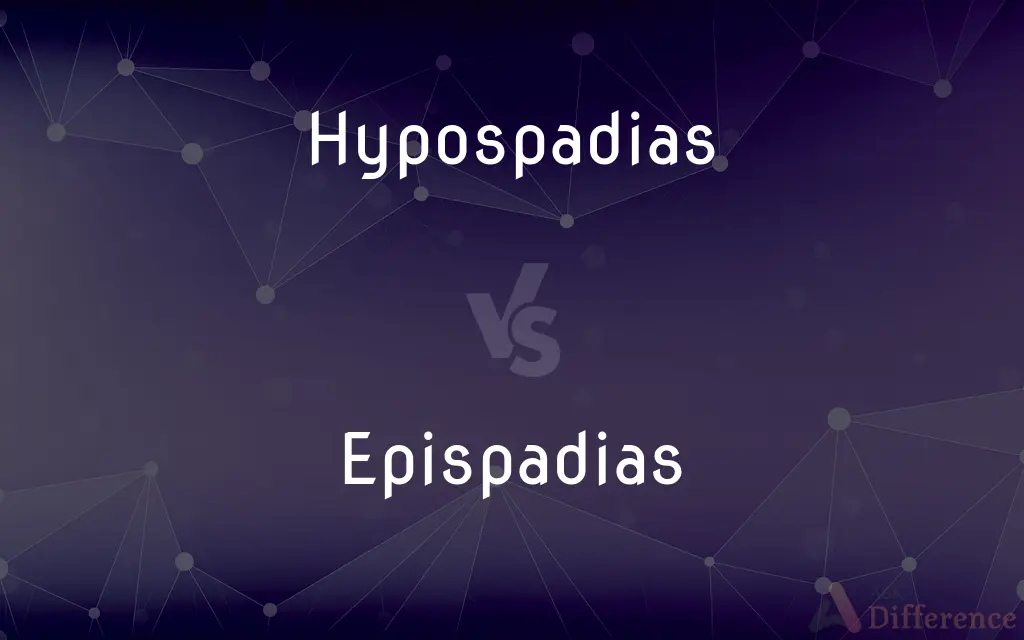Hypospadias vs. Epispadias — What's the Difference?
Edited by Tayyaba Rehman — By Maham Liaqat — Updated on April 7, 2024
Hypospadias involves the urethral opening located on the underside of the penis, while epispadias presents the opening on the upper side. Each affects urination and sexual function differently.

Difference Between Hypospadias and Epispadias
Table of Contents
ADVERTISEMENT
Key Differences
Hypospadias is a congenital condition where the urethral opening is located on the underside of the penis rather than at the tip. This abnormality can affect urination, leading to spraying or difficulty directing the urine stream, and may impact sexual function in adulthood if severe and untreated. Epispadias, on the other hand, is a less common congenital condition characterized by the urethral opening being positioned on the upper side of the penis. Like hypospadias, it can complicate urination and, in severe cases, sexual function, but it is often associated with a broader spectrum of issues, including potential involvement with bladder exstrophy, where part of the bladder is exposed outside the body.
The distinction between hypospadias and epispadias primarily lies in the location of the urethral opening and the potential association with other congenital anomalies. While both conditions can significantly impact a person's quality of life, especially if untreated, the approaches to their management and potential outcomes may differ. Early diagnosis and intervention are crucial for both conditions to ensure optimal urinary function and cosmetic outcomes.
Despite the challenges that hypospadias and epispadias present, advancements in medical and surgical techniques have significantly improved the prognosis for affected individuals. Successful treatment not only addresses the functional and cosmetic aspects but also focuses on the psychological well-being of the patient, emphasizing the importance of holistic care.
The understanding of hypospadias and epispadias highlights the complexity of congenital urological conditions and the importance of specialized medical care. Each condition, while distinct, underscores the necessity for personalized treatment plans that consider the unique circumstances of each patient, ensuring that they can lead a life with minimal limitations related to their condition.
Comparison Chart
Urethral Opening Location
On the underside of the penis.
On the upper side of the penis.
ADVERTISEMENT
Commonality
More common congenital condition.
Less common compared to hypospadias.
Associated Conditions
Rarely associated with other anomalies.
Often associated with bladder exstrophy.
Impact
Affects urination and potentially sexual function.
Affects urination, sexual function, and may involve more severe bladder issues.
Treatment
Surgical correction of the urethral opening.
Surgery to correct the urethral opening and any associated anomalies.
Compare with Definitions
Hypospadias
A congenital condition with the urethral opening on the penis's underside.
Surgery can correct hypospadias, improving urinary function.
Epispadias
A rare congenital condition with the urethral opening on the penis's upper side.
Epispadias is often treated through reconstructive surgery.
Hypospadias
Can affect sexual function if severe.
In adulthood, untreated hypospadias might impact sexual health.
Epispadias
Can complicate urination and sexual function.
Due to epispadias, he had surgery to normalize urination.
Hypospadias
Impacts urination direction and force.
Hypospadias made it difficult for him to urinate standing up.
Epispadias
Involves comprehensive surgical treatment.
Epispadias treatment focused on both cosmetic and functional restoration.
Hypospadias
More common than epispadias.
Hypospadias occurs more frequently in males than epispadias.
Epispadias
Less common and often more complex than hypospadias.
Epispadias, while rarer, typically necessitates a multifaceted treatment approach.
Hypospadias
Typically addressed with surgical intervention.
He underwent hypospadias surgery in early childhood.
Epispadias
Frequently associated with bladder exstrophy.
His epispadias came with bladder exstrophy, requiring complex surgical correction.
Hypospadias
(anatomy) A congenital condition in males in which the opening of the urethra is on the underside of the penis.
Epispadias
An epispadias is a rare type of malformation in which the urethra ends, in males, in an opening on the upper aspect of the penis, and in females when the urethra develops too far anteriorly. It occurs in around 1 in 120,000 male and 1 in 500,000 female births.
Hypospadias
Hypospadias is a common variation in fetal development of the penis in which the urethra does not open from its usual location in the head of the penis. It is the second-most common birth abnormality of the male reproductive system, affecting about one of every 250 males at birth.
Epispadias
(anatomy) A deformity in which the urethra opens upon the top of the penis, instead of at its extremity.
Hypospadias
A deformity of the penis, in which the urethra opens upon its under surface.
Epispadias
A deformity in which the urethra opens upon the top of the penis, instead of at its extremity.
Hypospadias
An abnormal condition in males in which the urethra opens on the under surface of the penis
Epispadias
A congenital abnormality in males in which the urethra is on the upper surface of the penis
Common Curiosities
What is hypospadias?
A condition where the urethral opening is located on the underside of the penis, affecting urination and potentially sexual function.
Is surgery required for both hypospadias and epispadias?
Yes, surgical intervention is typically recommended for both conditions to improve urinary function and cosmetic appearance.
Can hypospadias and epispadias affect fertility?
While the conditions themselves don't directly affect fertility, complications or untreated cases might impact sexual function, potentially affecting fertility indirectly.
Are hypospadias and epispadias detectable before birth?
They can sometimes be detected through prenatal ultrasounds, though diagnosis is often made at birth or shortly thereafter.
What causes hypospadias and epispadias?
The exact causes are unknown, but factors may include genetic variations and environmental influences during pregnancy.
What is the prognosis for someone with hypospadias or epispadias?
With proper surgical treatment, the prognosis is generally good, allowing for normal urination and reduced impact on sexual function.
Is it possible to have both hypospadias and epispadias?
These conditions are mutually exclusive due to their distinct locations of the urethral opening.
How does epispadias differ from hypospadias?
Epispadias is characterized by the urethral opening being on the upper side of the penis, and is often more complex due to its association with other conditions like bladder exstrophy.
Can hypospadias be treated without surgery?
Surgery is the primary treatment to correct the urethral opening's position; there are no effective non-surgical treatments.
How soon after birth is surgery for hypospadias or epispadias recommended?
Surgery is typically recommended within the first year of life to ensure optimal outcomes, but timing can vary based on individual circumstances.
How common is hypospadias compared to epispadias?
Hypospadias is more common than epispadias, with a higher incidence rate in newborn males.
What is bladder exstrophy?
A rare congenital condition where the bladder is exposed outside the body, often associated with epispadias.
Can epispadias lead to other health issues?
Yes, especially if associated with bladder exstrophy, it can lead to urinary tract infections and kidney problems if not treated properly.
Do hypospadias and epispadias have genetic links?
There may be a genetic component, as these conditions can occur more frequently within certain families.
Share Your Discovery

Previous Comparison
Moisturizer vs. Emulsion
Next Comparison
Nucleophilicity vs. BasicityAuthor Spotlight
Written by
Maham LiaqatEdited by
Tayyaba RehmanTayyaba Rehman is a distinguished writer, currently serving as a primary contributor to askdifference.com. As a researcher in semantics and etymology, Tayyaba's passion for the complexity of languages and their distinctions has found a perfect home on the platform. Tayyaba delves into the intricacies of language, distinguishing between commonly confused words and phrases, thereby providing clarity for readers worldwide.
















































